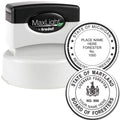Natural light, a comfortable workspace, or even organizing your daily files can make a huge difference in your office routine. But when it comes to checking off those crucial quality requirements, you need something more robust. That’s where inspection stamps come in. Whether you handle quality control in a large facility or manage a small workshop, finding the perfect stamp can help you streamline tasks and maintain consistent standards. Ready to see how it all comes together? Let’s walk through what matters most when selecting these handy tools.
Understand Inspection Stamps
Inspection stamps help you mark products, paperwork, or packaging to indicate quality checks, approvals, or specific stages in your process. Think of them like your personal signature, except they’re quicker, more uniform, and easily recognized by teammates or regulatory bodies.
What They Are
Traditionally, these stamps are made from rubber or polymer. You ink them and press them onto surfaces to confirm that something has passed inspection or meets a given standard. If you’re working in QA (quality assurance) or QC (quality control), having a clear, legible stamp gives everyone a heads-up that an item has been checked and approved.
Why They Matter
You might wonder, “Why not just sign off with a pen or a digital form?” Handwritten signatures can vary from day to day, and digital forms may lose their punch in physical production settings. A consistent stamped mark reduces confusion and helps track compliance. Plus, it’s a way to unify your inspection process. When your entire team uses official markings, everything looks and feels more professional and reliable.
Identify Your Specific Needs
Before you invest in a stamp, it’s wise to pin down your exact requirements. After all, your inspection routine might be different from the next person’s.
Frequency And Volume
How often do you need to stamp in a typical shift? If you’re stamping hundreds of items daily, a self-inking or pre-inked option might save you time. On the flip side, a small business that only stamps a few forms per week may prefer a classic rubber handle for simplicity.
Surface And Environment
Where do your checks happen? In a climate-controlled office or a hot, dusty workshop? If it’s the latter, you need a durable stamp that can handle less-than-ideal conditions. Many stamps today are built to withstand occasional drops and bumps, but not all materials are equal. Also, if you’re stamping on awkward surfaces like curved parts or oddly angled products, certain stamp shapes or sizes will make your work easier.
Choose The Right Material
The material of your stamp directly impacts its longevity and the clarity of each impression. Generally, you’ll choose from rubber, polymer, or metal.
| Stamp Type | Pros | Cons |
|---|---|---|
| Rubber | Durable, cost-effective | Requires separate ink pad |
| Polymer (Pre-inked) | Offers crisp impressions, compact | Limited ink capacity, costlier |
| Metal Body | Extremely durable | Typically heavier, may cost more |
Rubber For Flexibility
Rubber stamps are a classic for a reason. They’re affordable and easy to care for. If you don’t mind having a separate ink pad, they get the job done without fuss. They’re also good for custom shapes or intricate designs.
Polymer For Crisp Prints
If you’d rather skip an external pad, pre-inked polymer stamps might be your best bet. These come with ink stored within the stamp itself, making them super convenient. They typically produce very crisp marks, which is great if you need detailed text or small lettering.
Consider Ink Options
Choosing the right ink is almost as important as choosing the stamp. Some environments need specialized formulations to handle extreme temperatures or chemical exposure.
Permanent Vs. Non-Permanent
Some businesses prefer permanent ink for compliance reasons because it won’t easily fade or wash off. However, if your inspections happen in a more flexible environment, non-permanent ink might suffice. Non-permanent inks can be cleaned off if an item needs re-checking.
Think About Colors
Let’s be honest, red is everywhere for quality stamps. But sometimes, you want a more subtle shade like black or blue, or even something that aligns better with your brand’s look. If you’re stamping on dark surfaces, a bright white or metallic ink could ensure your mark is visible.
Plan Your Stamp Design
Once you’ve nailed down the perfect material and ink, it’s time to make your stamp uniquely yours. An eye-catching mark doesn’t just help with identification, it also promotes professional pride.
Pick Up Key Details
What information do you need to display? Common elements include:
- Your business name or initials
- A unique code or number
- A date field
- An approval or rejection note
Including a date field can be especially handy for time-sensitive products. If you’re dealing with large volumes, a code that identifies specific batches may streamline your records.
Add A Personal Touch
If branding matters, consider adding your logo. A quick, noticeable brand impression can reassure clients and coworkers alike that you take inspections seriously. For instance, a company logo inspection stamp can set you apart and put your brand at the center of every approved item.
Maintain And Store Properly
You’ve seen the frustration of a dried-out or crooked stamp. A bit of care goes a long way in keeping them in shape.
Clean Regularly
Ink, dust, and manufacturing debris can accumulate on the stamping surface. Gently wipe off ink residue with a damp cloth, and avoid soaking the stamp since water can warp the rubber or polymer. Occasional deep cleaning helps you maintain crisp impressions over time.
Store In A Safe Spot
Even if you opt for a super-durable model, treat your stamp with care. Keep it in a designated drawer or container without heavy items on top. Excess pressure or sharp objects can deform the stamp, eventually leading to blotchy marks.
Pick A Reliable Supplier
You’ve probably heard the saying: A tool is only as good as the company behind it. The same applies to inspection stamps. A dependable supplier ensures quality materials, faster turnaround, and better customer support.
Why ESS?
At ESS, we’ve been family owned and operated since 1964, priding ourselves on excellent customer service and top-notch products. Whether you need a simple date stamp or a highly customized QA stamp, we can help you get exactly what you’re after. With decades under our belt, we understand how important it is to meet your inspection needs quickly and accurately.
Speed And Support
When you’re in the middle of a production cycle, every day counts. ESS offers fast turnaround, so you can get your stamps in hand without slowing down your process. Plus, if you have any questions about materials, designs, or specialized ink, our team is just a phone call or message away.
FAQs About Inspection Stamps
1. Can I Use Multiple Ink Pads With One Stamp?
Yes. If you have a traditional rubber-handled stamp, you can simply switch ink pads. Just make sure you clean the stamp surface in between uses to avoid color mixing or ink buildup.
2. How Often Should I Replace My Stamp?
It depends on overall usage and storage. With regular care, a well-made rubber or polymer stamp can last for years. Pre-inked stamps may need refills or replacement modules more frequently, depending on how heavily you use them.
3. Are Custom Designs More Expensive?
They can be slightly pricier because there’s extra work in creating your unique layout. However, the difference is often minor. If your business benefits from having a professional, branded mark, the investment can be well worth the additional cost.
4. What If I Need Specialty Ink?
Some suppliers, including ESS, can provide inks formulated for special surfaces, high-temperature environments, or safety compliance. Ask your stamp provider for recommendations if you’re working in a unique setting.
5. Is A Self-Inking Stamp Right For Me?
It can be, especially if you handle a moderate or high volume of inspections. Self-inking models let you stamp multiple times in a row without re-inking. Try one out if you value speed and convenience.
Final Thoughts
Selecting your ideal inspection stamps doesn’t have to be complicated once you understand your workload, environment, and design preferences. By picking the right material, ink type, and features, you’ll end up with a stamp that feels customized to your unique workflow. And when you’re ready to bring everything together, consider partnering with a trusted supplier like ESS to get a tailored product backed by excellent customer support. After all, a smooth and professional stamping process is one of those small but powerful ways to keep your quality control on point. Good luck, and happy stamping!


















